Internal links are SEO 101: they help Google discover, crawl, and index pages on your website.
Without smart internal linking, pages sit dormant on your site, siloed from Google, and void of organic traffic. Worse, a poor internal link structure creates a poor user experience, making it difficult for visitors to find pages they need, leading to higher bounce rates.
Internal linking increases the odds that more of your pages will show up in search results and generate traffic, but you can use them strategically to pass page authority from one page to another.
The result? A better distribution of SEO juice.
TL;DR
We do SEO so Google rewards us with a spot under the search bar that people see. SERP visibility is the first part of the game to get that conversion. If your link shows up in the search engine results pages, the odds someone clicks it and jumps to your page. If you do your CRO right, that CTR turns into CVR (a click from the SERP turns into a conversion). That process works well if you internally link your site in a way that makes sense to the Google bots. By the end of this page, you will know 9 ways to rock internal linking so you can rank higher, rank more pages, and make it easier for people and search engines to navigate your site easily.
Let's go!- What are internal links?
- Why are internal links important for SEO?
- Building an internal linking strategy
- Types of internal links
- 2. Place contextual links within page copy
- 3. Use internal linking to reduce page depth (link deep)
- 4. Use hubs and spokes to boost rankings
- 5. Use descriptive anchor text in internal links
- 6. Update older pages with internal links to new posts
- 7. Don't use too many internal links
- 8. Reclaim link juice by fixing broken internal links
- 9. Use dofollow links 99.99% of the time
- Internal linking strengthens the internal structure of your website
Get brand new SEO strategies straight to your inbox every week. 23,739 people already are!Sign Me Up
What are internal links?
Internal links are hyperlinks from one page on your website to another page on your website. Unlike external links, internal links (as the name suggests) stay within the same domain; they link to internal pages.
For example, your website navigation incorporates internal linking: navigation buttons point website visitors (and search engine crawlers) to other pages within your site.
Think of internal links in the same way you might think of a backlink (a backlink is when another website links to your website), only internal links are backlinks for pages within your site. Like backlinks, internal links also pass page authority from one page to another.
Internal Links vs. External Links
Internal links are different from external links, which point to pages on other domains.
Google wants to cruise around the network of internal links you create to tie everything together at your domain. And Google wants to follow the external links you put on your site that point away to other pages. In the same way, Google's search engine crawlers get to your page by following external links on other websites that point to your page, too (backlinks).
Googlebots understand these relationships between content.
While external links provide additional information and context to users, internal links are essential for establishing a website’s structure and helping search engines understand the relationships between a website’s pages. Internal links distribute link equity throughout a website, which can improve the ranking of important pages.
Why are internal links important for SEO?
Other than the fact that Google literally crawls the internet using links, there are four core search engine optimization benefits to quality internal linking that make it a must for any solid SEO strategy. Having sufficient internal links pointing to various pages is crucial to prevent orphaned content, which can hinder search engines from discovering and indexing those pages efficiently.
1. Improve user experience
First and foremost, good internal linking creates a good user experience: The easier it is for visitors to find relevant pages, the more effortless their experience. And what's good for the user is good for Google.
Poor internal linking leads to poor site structure and a poor user experience: limited time on site, high bounce rates, fewer pages per visit, fewer conversions, more frustration.
2. Increase rankings
Think of internal links in the same way you might think of a backlink, only internal links are backlinks for pages within your site. On a web page, link value is distributed among the links, with the homepage generally having the highest link value due to its accumulation of backlinks. Like backlinks, internal links also pass page authority from one page to another, which in turn helps boost SERP rankings.
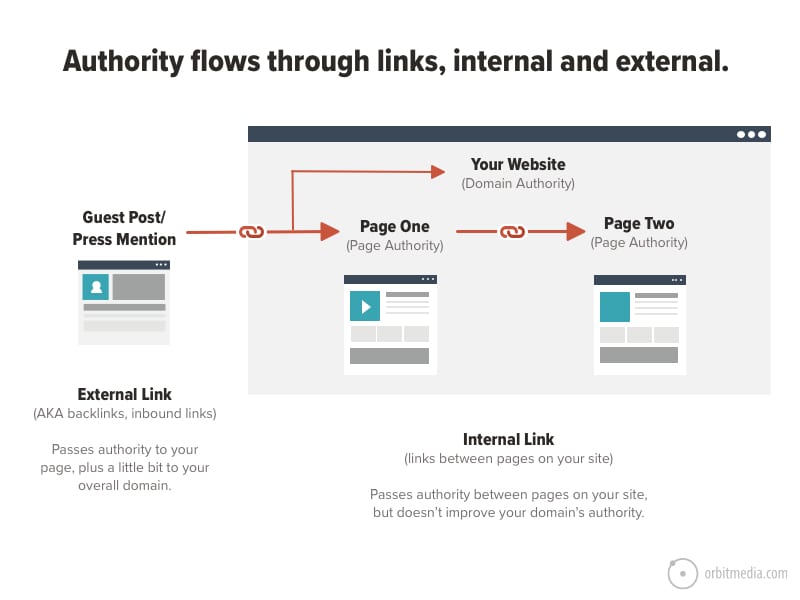
3. Increase indexing
Websites get a limited “crawl budget” from search engines like Google. What's a crawl budget? In a given timeframe, Google's algorithms only crawl and index (AKA “budget”) a certain amount of pages on your website.
For most websites, all pages will fall within a given budget. But for bigger sites (100+ pages), many pages may not. Which means not all pages will get indexed.
Internal linking helps Google find, prioritize, crawl, and index deep pages on your website faster so more of them get indexed within your budget.
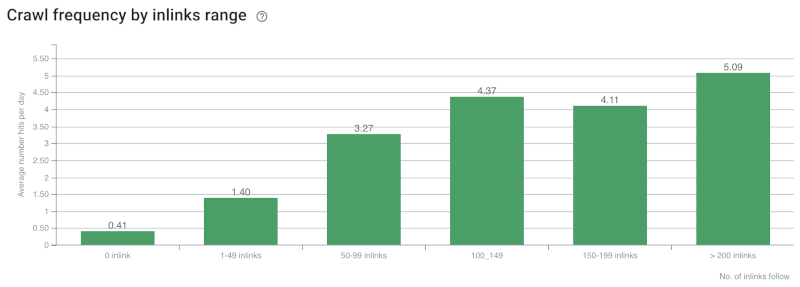
4. Increase conversions
Calls-to-actions (CTAs) help move users from one stage of their journey to the next. They motivate action and help visitors complete goals quicker.
The end goal of SEO is to move from rankings to revenue. And you can't do that without well-placed CTAs.
Building an internal linking strategy
A well-planned internal linking strategy is essential for improving a website’s user experience, search engine rankings, and overall performance. Here are some steps to help you build an effective internal linking strategy:
What is your most important content?
Dont' jump into internal linking without a strategy.
Identify the most important content on your website. Those pages should show up in the main navigation at the top of the page and in the footer. They are at the top of the hierarchy of your website. Those pages should link to each other first. Then add more links to establish the relationships between different pages and sections. A well-organized website structure helps search engines understand the context of your content and improves user navigation. Identify your cornerstone content, product pages, and other key pages that you want to highlight.
Types of internal links
There are four primary groups of internal links to include on your site.
Main navigation links: These are links that appear in your website’s navigation and appear on every page of your website (coded into the < header>). They can also appear in sub-navigation menus too.
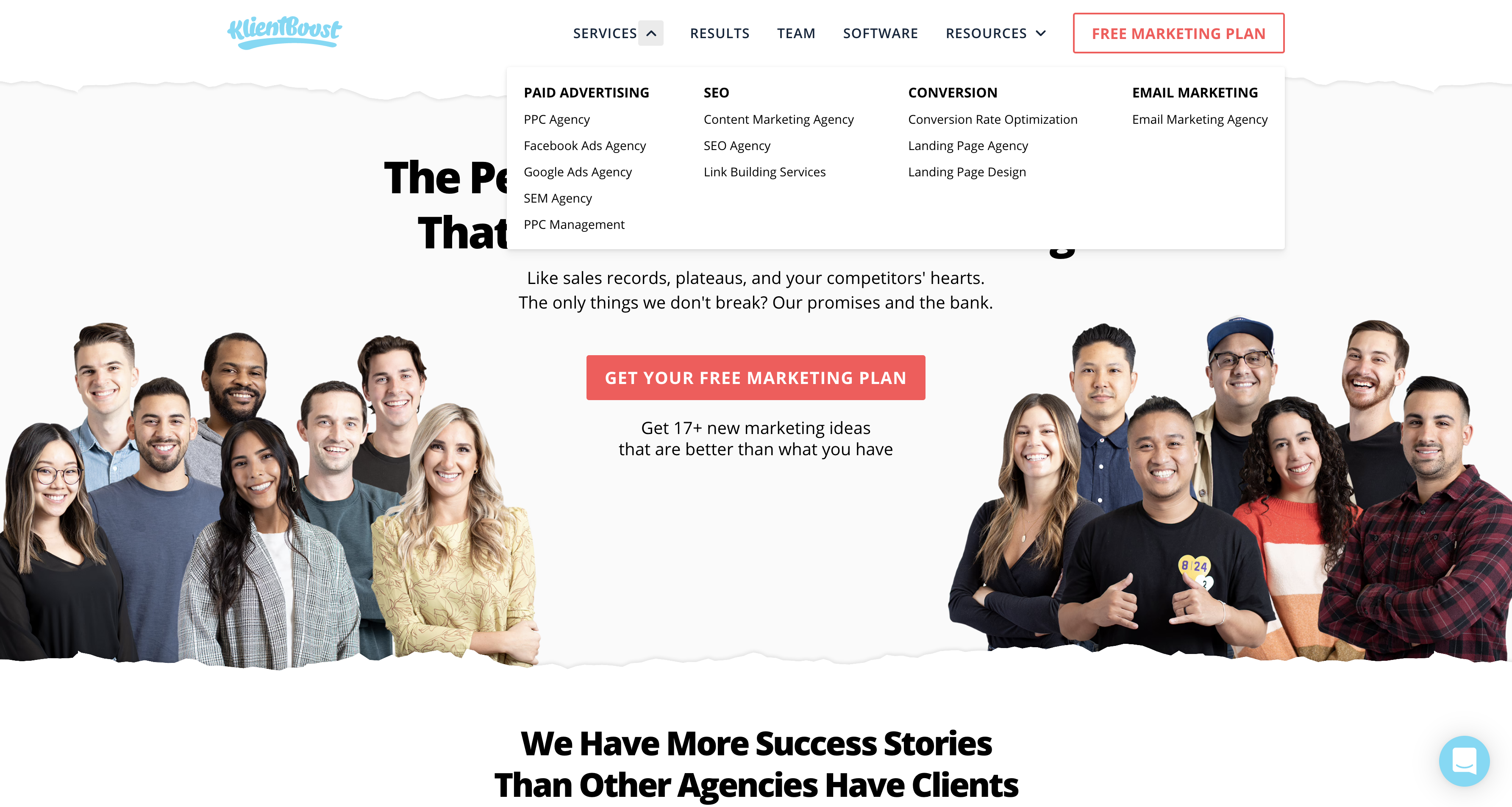
Footer links: Like navigation links, footer links also appear sitewide in the footer at the bottom of every page.
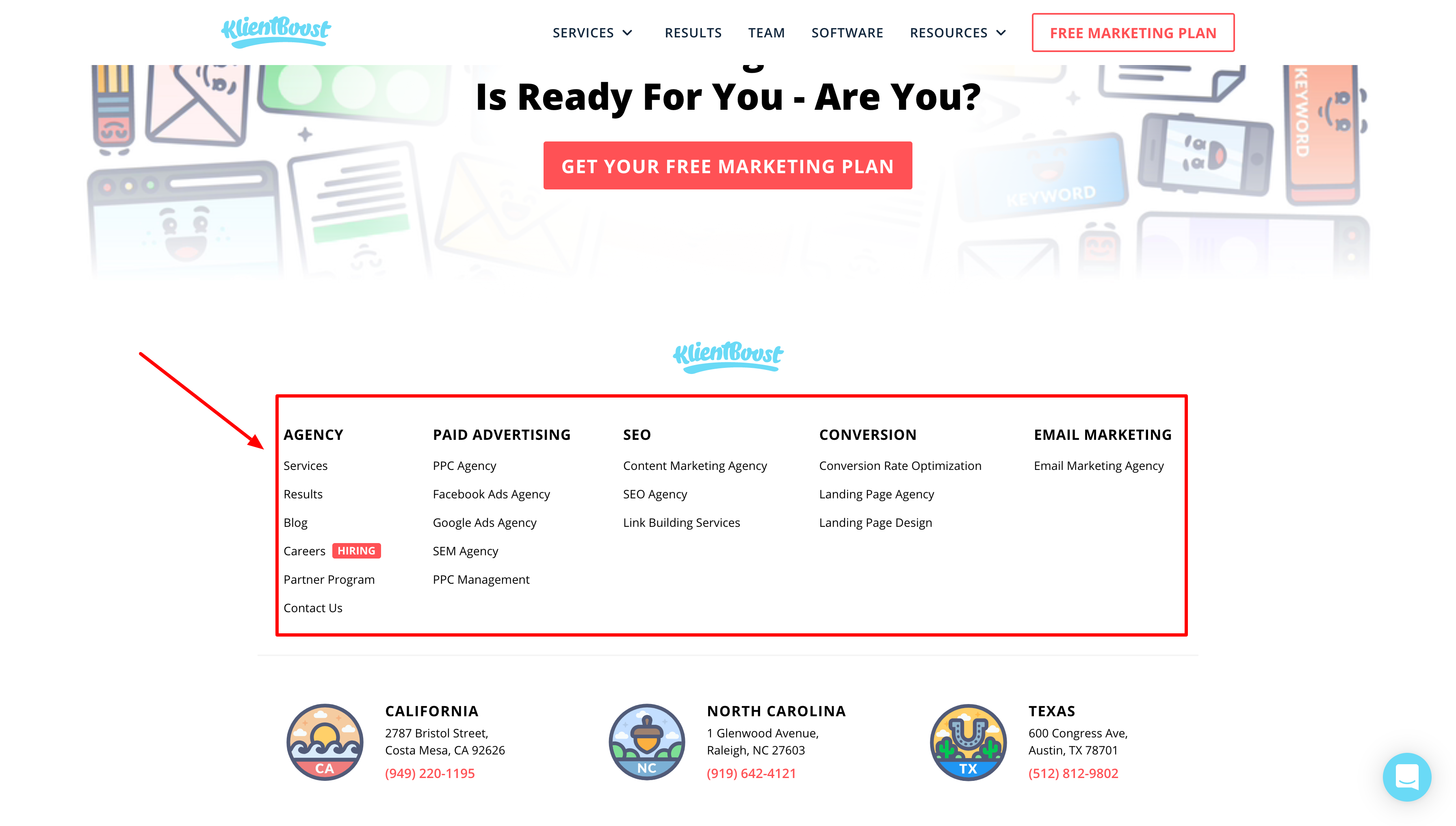
Sidebar links: Sidebar links (usually found on blogs) allow you to link to popular posts, related posts, latest posts, calls-to-action, or any time of content you want.
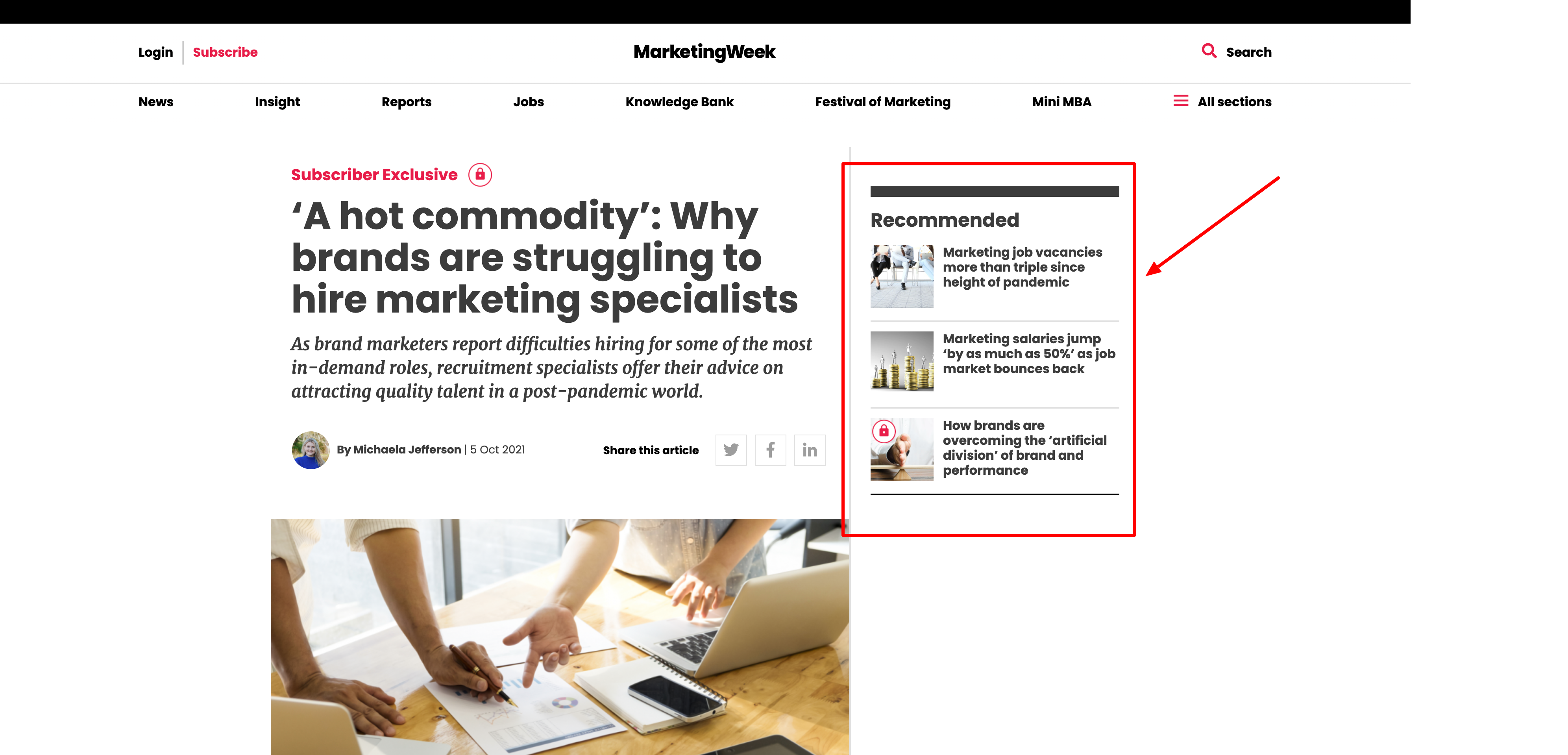
Contextual links: Contextual links are nestled directly within the body of your content. They can be links to related articles, calls-to-action, or any other relevant and related resource on your site.

External links point to pages on different domains and play a crucial role in enhancing a page's authority and credibility. They can drive referral traffic and help build trust when connected to reputable sources.
Let’s dive into the most critical steps to optimizing your internal links. An effective internal linking strategy awaits!
An authority page is a page on your website that has already accumulated backlinks and PageRank
Since internal links pass page authority from one page to another, use your most authoritative pages to boost the rankings of less authoritative but important pages by interlinking them together.
You can use a tool like SEMRush (paid), Ahrefs (paid), or Google Search Console (free) to pull a report on your top pages (pages with most backlinks from quality domains).
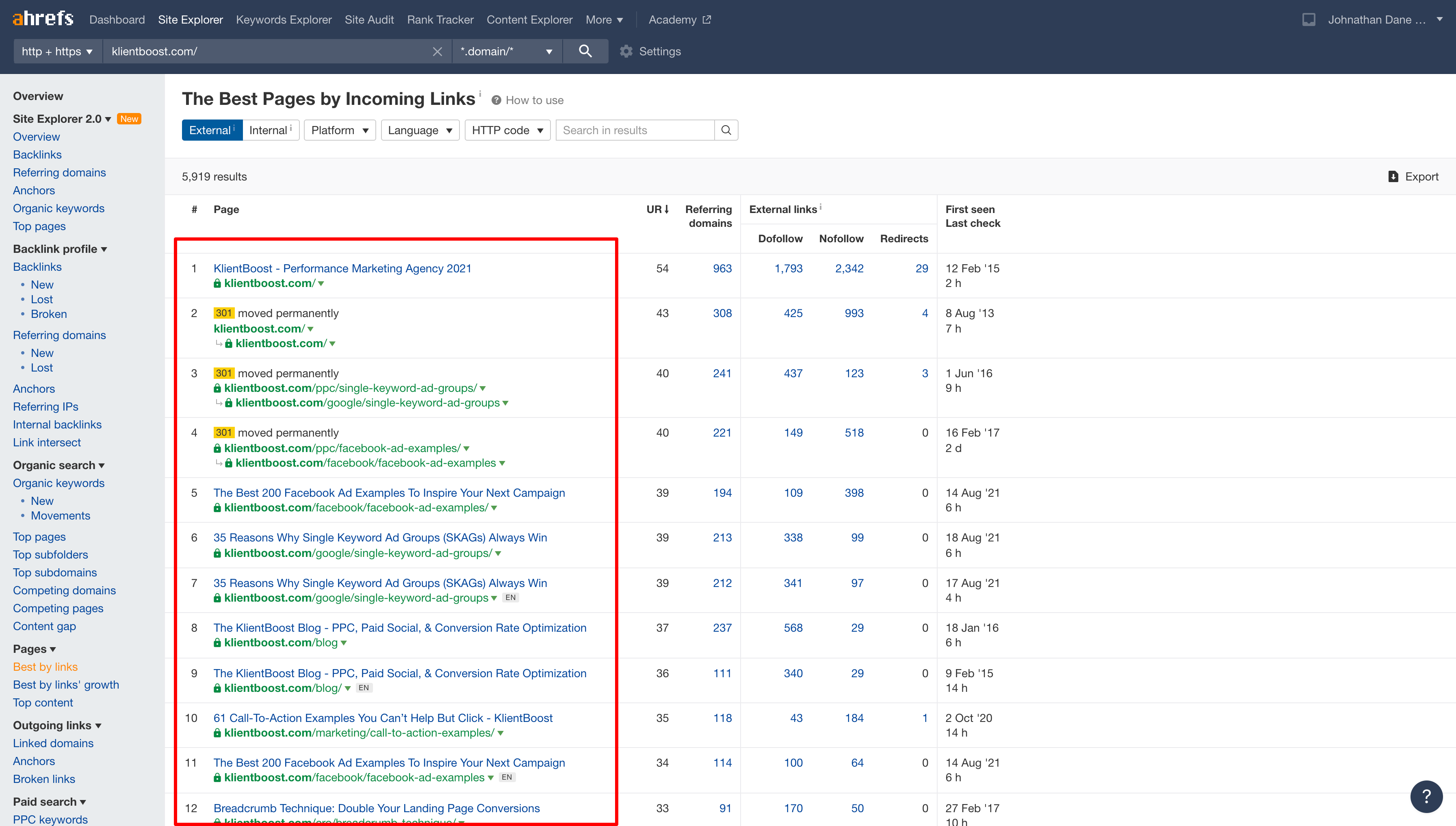
From there, using one of the same tools, you can identify which target pages rank on page one between positions 2-9. (Find your rankings and filter by position.)
Why? Because these are the pages that have the most to gain from an authoritative internal link. One internal link could shoot them to the top of page one.
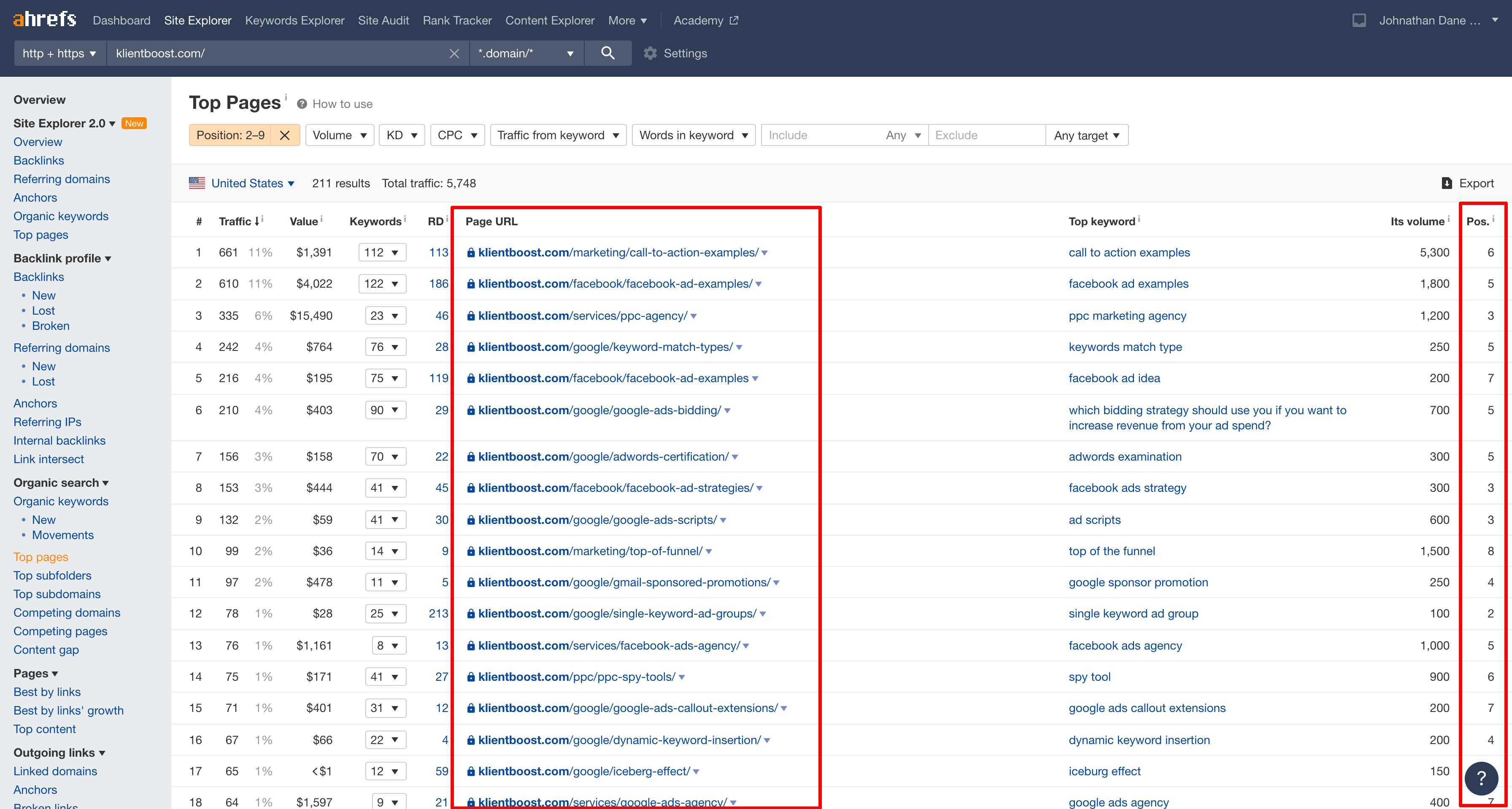
Now place a link from your authoritative page to your high page one page. Viola!
2. Place contextual links within page copy
Contextual links are links within the body of a page that link to relevant pages on your site. Keyword: related. Contextual links deepen the conversation or aid the visitor on their current journey.
External links pointing to a website are also crucial as they enhance the site's authority and credibility in the context of SEO.
Don’t arbitrarily link to other pages in an attempt to flatten your site architecture (reduce page depth) or pass along link equity.
Link to pages that are relevant: if it’s not related or doesn’t help the visitor on their journey, don’t do it.
You can add contextual links directly within the body copy, as a “further reading” block at the end of an article, or in a box within an article. Wherever you add them, make them make sense.
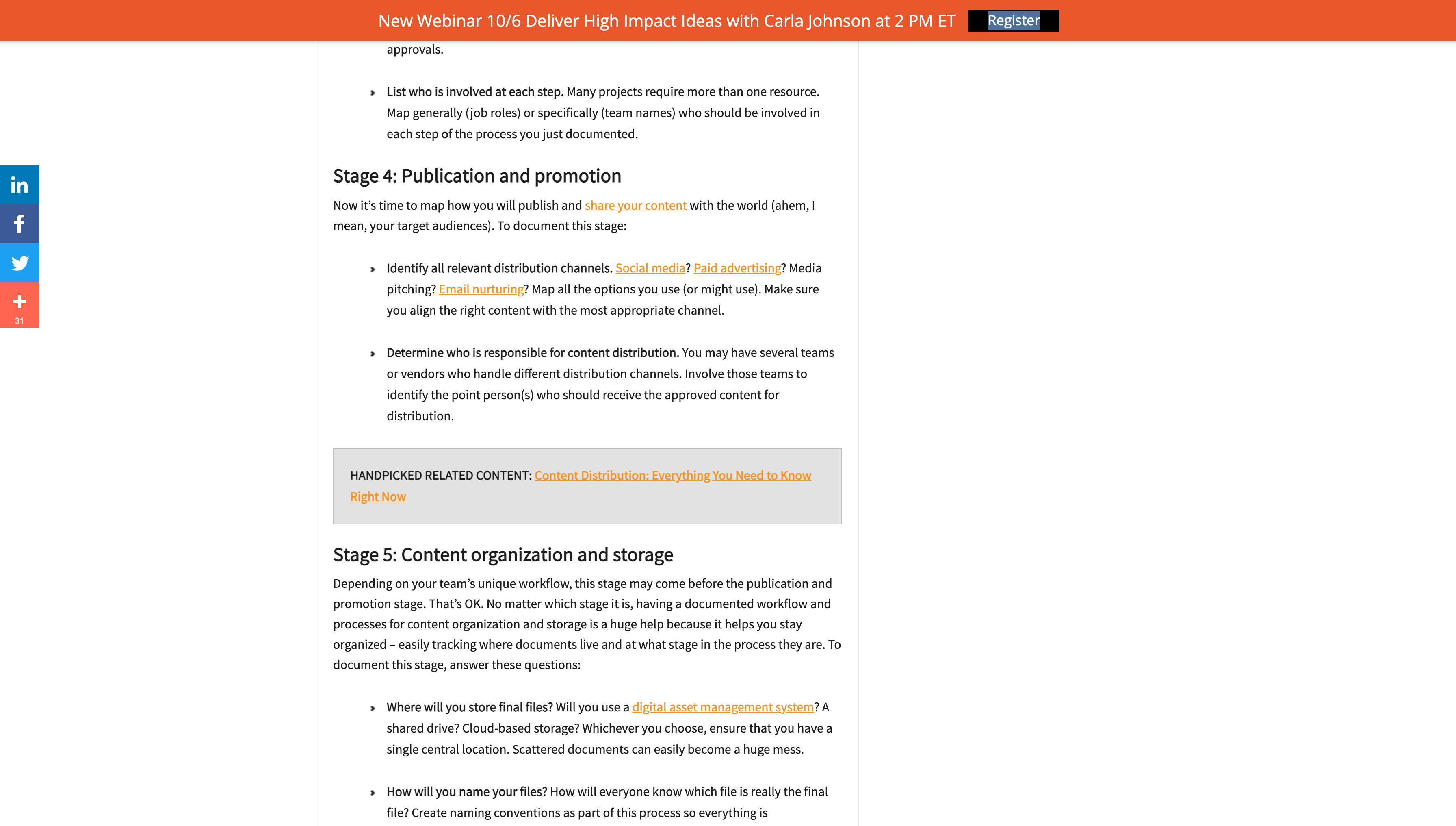
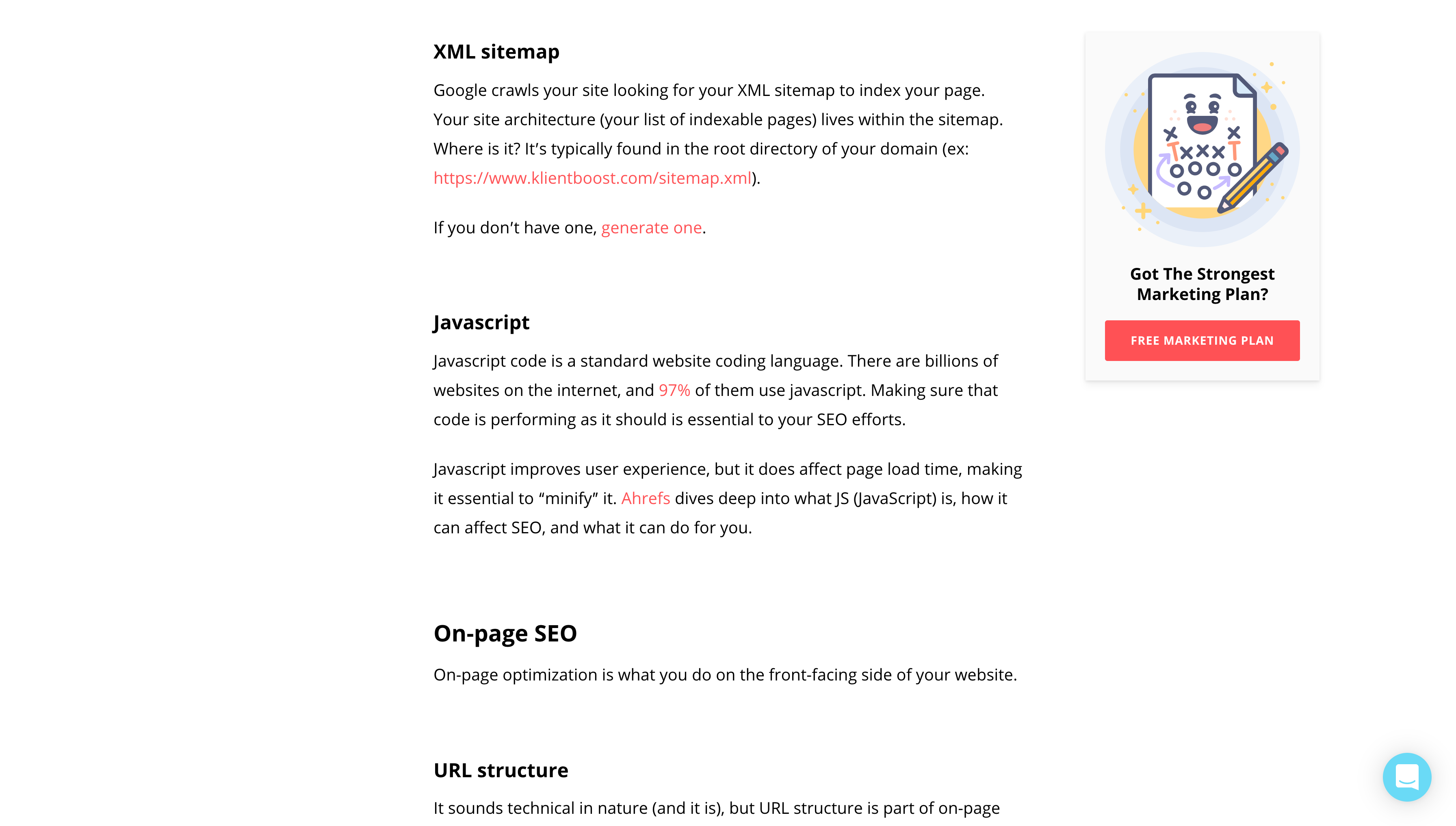
3. Use internal linking to reduce page depth (link deep)
Page depth refers to the number of clicks away from the homepage a visitor needs to travel to get to a specific page.
Remember the crawl budget?
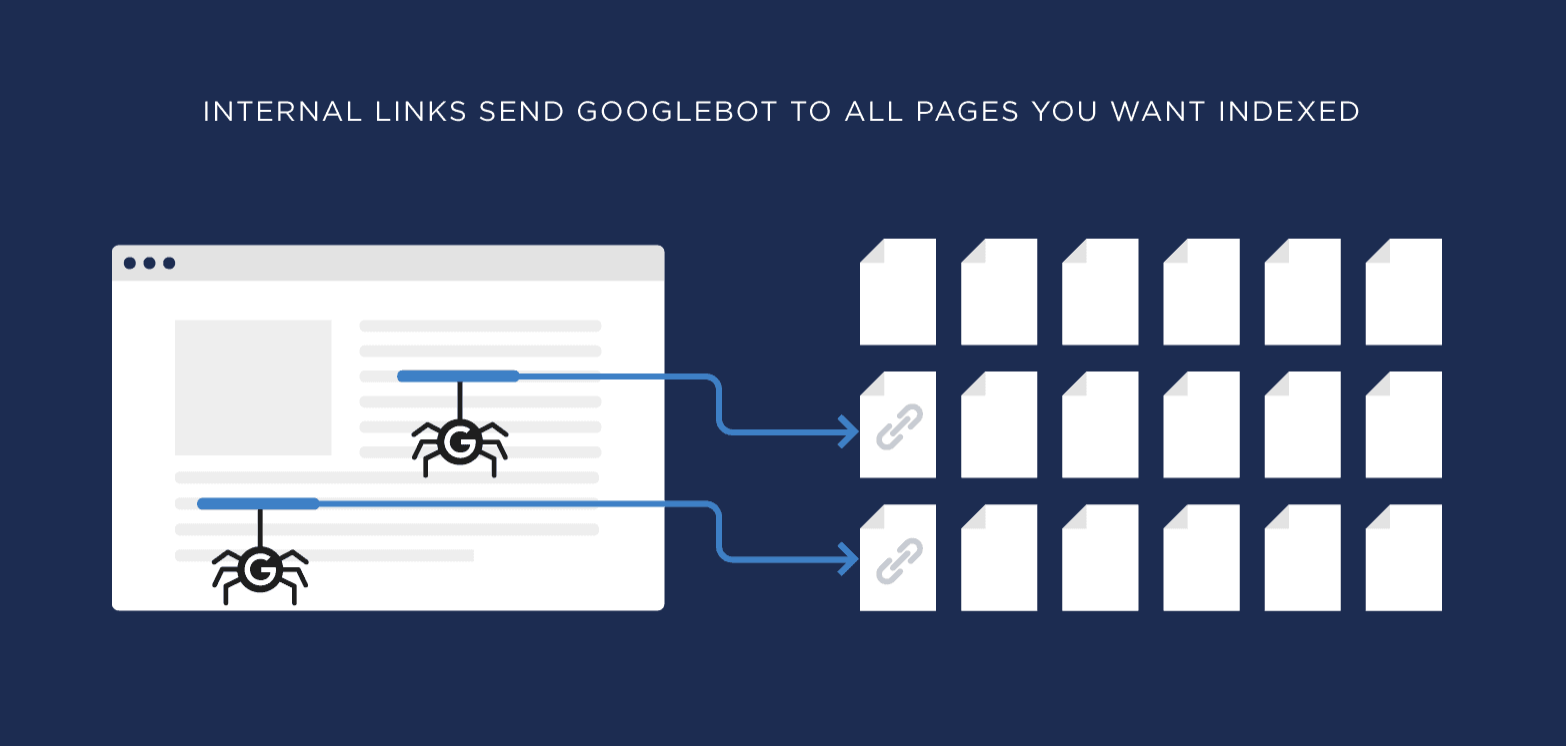
The deeper the page (more clicks away from the homepage), the harder it is for Google to find and crawl them.
According to Google's John Mueller, pages that are closer to the homepage signal to Google that they're more relevant, so they reward them with more weight:
In general, it's best practice to keep page depth between 1-3 clicks from the homepage. Anything else may signal low priority to Google.
In a study from OnCrawl, they found that pages closer to the homepage were more likely to get crawled. And pages that were more than three clicks from the homepage were crawled significantly less.

Four ways to bring pages closer to the top:
- Use “related posts” or “recommended products” sections often so each page has a customizable sub-navigation
- Increase the number of posts or products on category pages so it takes fewer clicks to browse them all
- Use website navigation to keep core pages one click away
- Increase the number of categories (for articles or products) using the hub and spoke model (below)
4. Use hubs and spokes to boost rankings
We're a big fan of the hub and spoke model here at KlientBoost.
What is it? A better way to organize your information (and internal linking structure) topically.
Hubs function as a home for a big, broad topic that you'd never be able to rank for alone. Hubs are like category pages.
Spokes function as individual articles that drill down deeper into subsections of the big, broad topic. Spokes are like subcategories.
And links keep them topically connected.
For example, here is our hub and spoke for Google Ads.
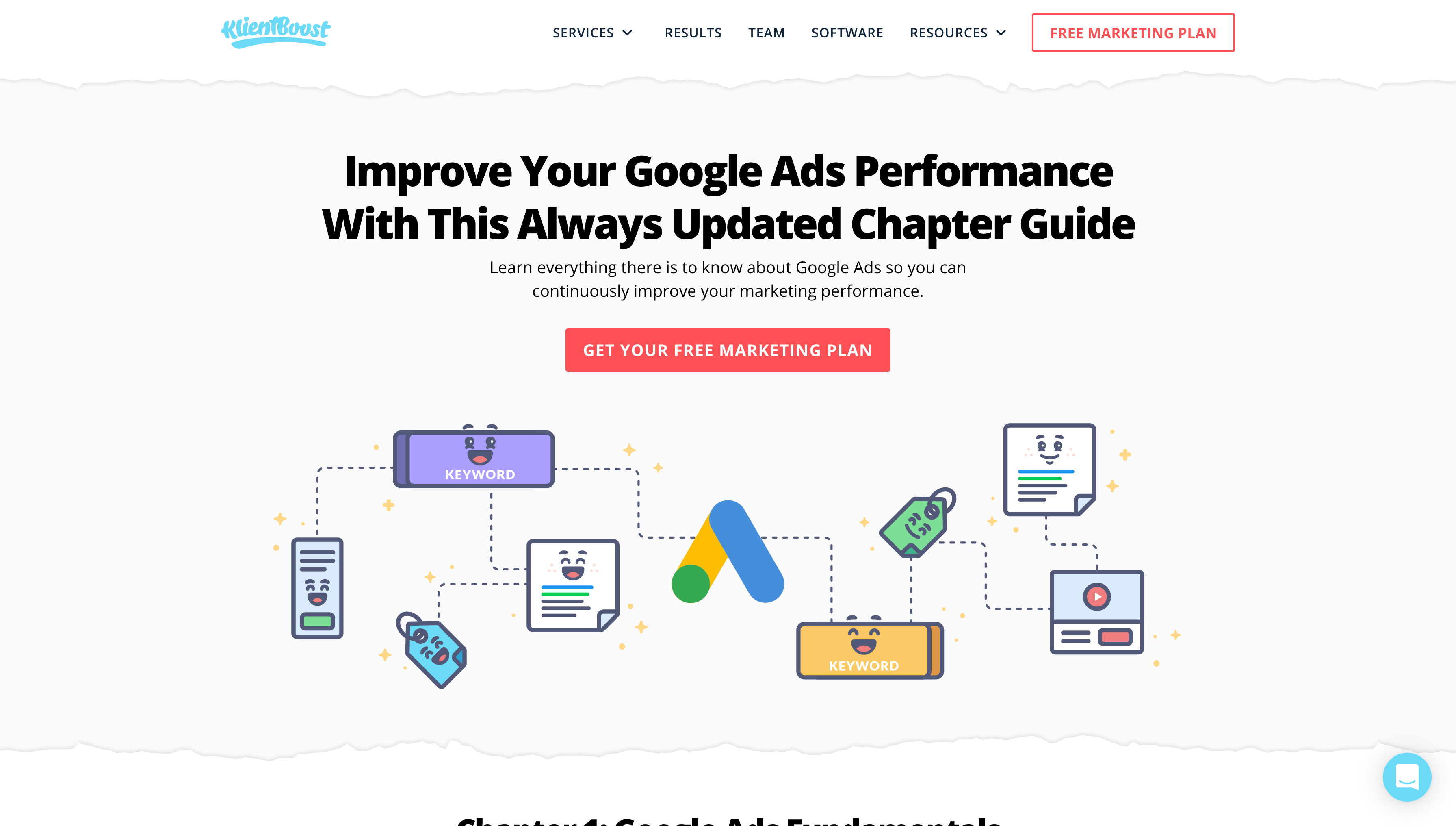
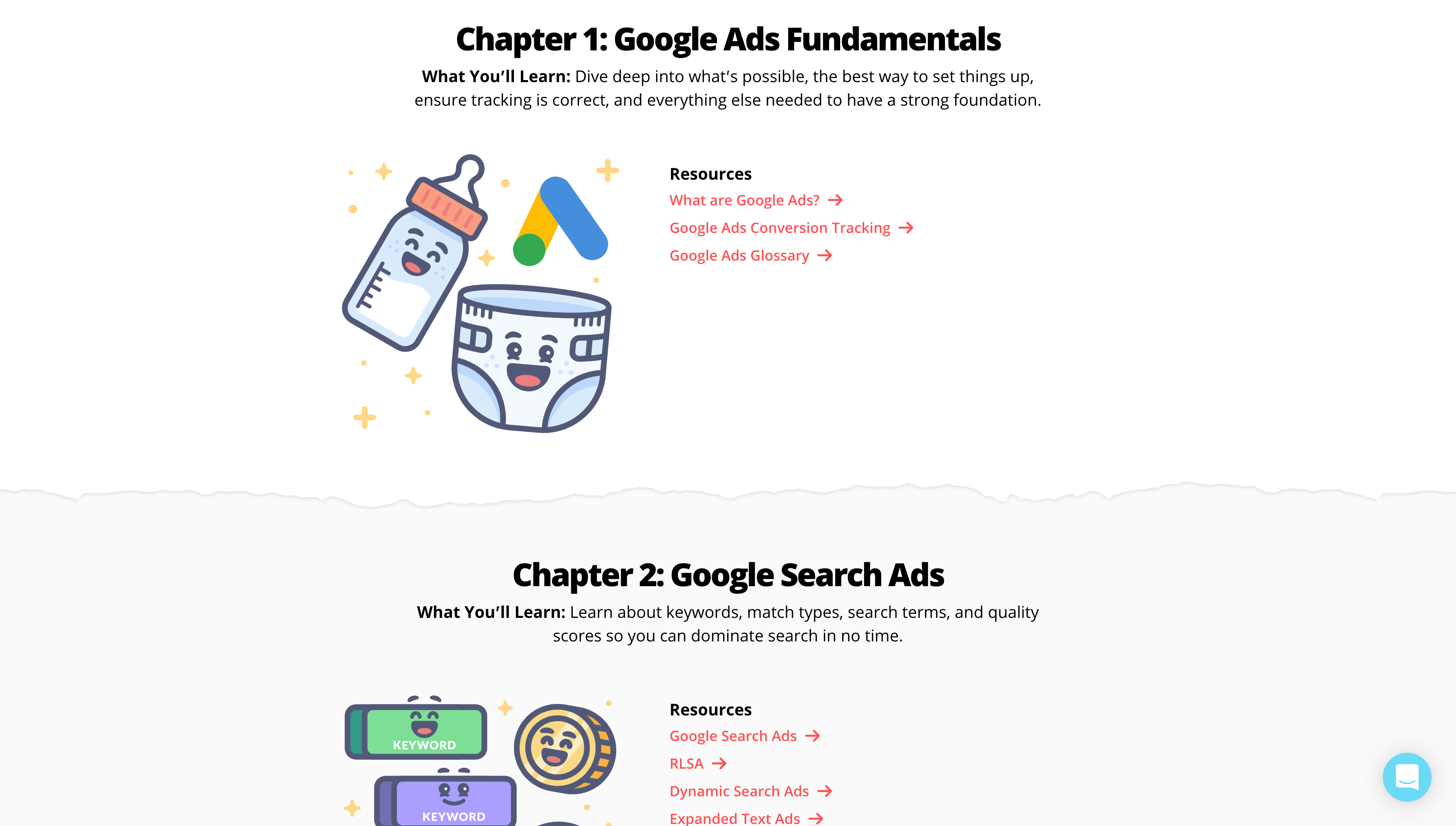
Together, hubs, spokes, and links can:
- Create a better user experience by offering an easily navigable landing page for core topics
- Reduce page depth by bringing topically related articles in one hub fewer clicks from the homepage.
- Improve distribution of page authority (aka “SEO juice”) by linking hubs to spokes, spokes to spokes, and spokes to hubs
- Improve topical authority by helping search engines understand the relationship between pages
- Ensure no pages get put in silos (no links pointing to them)
5. Use descriptive anchor text in internal links
Anchor text is the “link text” or visible text of a link. For example, this is anchor text.
Anchor text helps indicate to search engines what the page you're pointing to is about.
And though Google has remained coy on the topic, several Google patents include anchor text (and surrounding text) as a ranking signal, and Google's John Mueller has suggested they use anchor text as a ranking signal as well.
Either way, providing more context to visitors and Google about what they can expect once clicking on a link indirectly influences rankings.
When choosing anchor text for internal links, keep it natural: Use anchor text that makes sense to readers, and don't overdo it with exact-match, keyword-heavy anchor text. If all your internal links are exact-match and stuffed with keywords, it will look suspicious to Google.
Optimize for diversity:
- Exact-match: PPC agency
- Partial-match (good for long-tail keywords): “When looking for an SEO agency for your startup…”
- Naked URLs: https://klientboost.com/services/ppc-agency/
- Generic text: Click here
- Branded: KlientBoost
6. Update older pages with internal links to new posts
Often overlooked (or forgotten), but an easy win: adding internal links from an old piece of content to new content.
Every 3-6 months, update older articles with relevant contextual links that point to new pages that didn't exist when you first wrote them.
7. Don't use too many internal links
Does the number of internal links on a page matter?
Years ago (2009 to be exact), Google's former head of webspam, Matt Cutts, stated that it's a good practice to keep total links (internal and external) on a single page below 100. And that pages with more than 100 links might not get all of them followed.
Though more recently, Google has suggested that having more than 100 links isn't a problem.
Either way, adding too many links can create an overwhelming user experience and look spammy. If your webpage has 300+ links, the entire page is going to be highlighted.
Not to mention the more internal links on a single page, the less page authority that page will pass through to each link. Link value declines with every new link.
Bottom line: don't overdo it in the name of user experience.
Note: if you're using WordPress, the YoastSEO plugin has a feature called “text link checker” that tells you exactly how many internal links each respective page is receiving.
8. Reclaim link juice by fixing broken internal links
According to SEMRush, 42.5% of all websites have broken internal links. A broken link is a link that points to a webpage that no longer exists.
And if you've ever experienced a new website build and migration in which URLs or directories change names, you know how messy broken internal links can get.
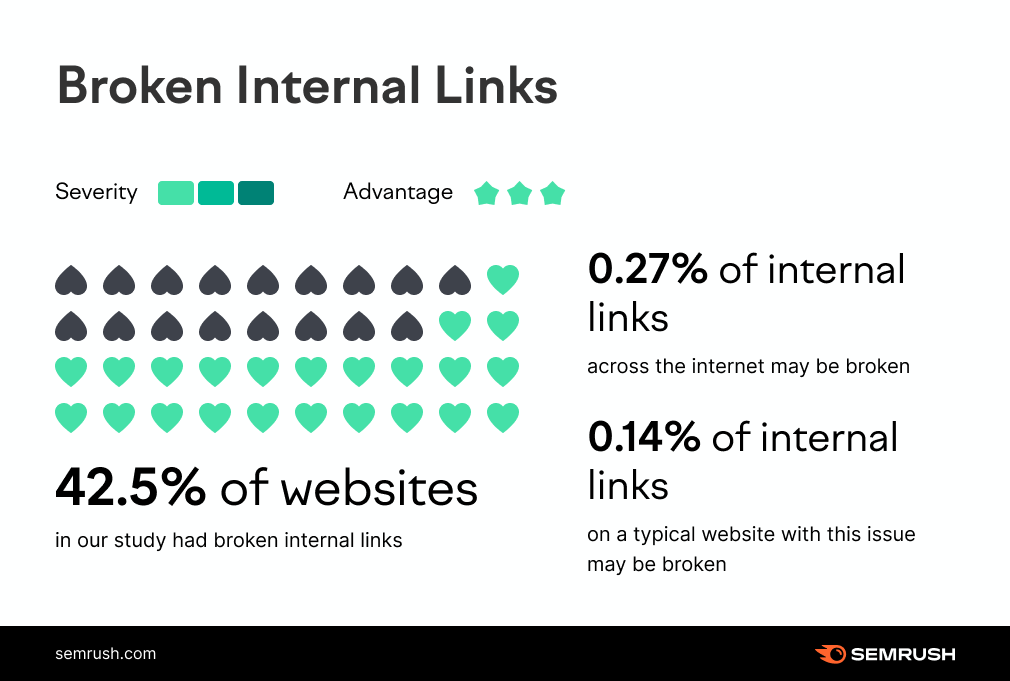
Finding and fixing broken internal links is easy.
Actually, all you need to do is type in your domain in Dr. Link Check's free broken link checker tool.
First, type in your domain.
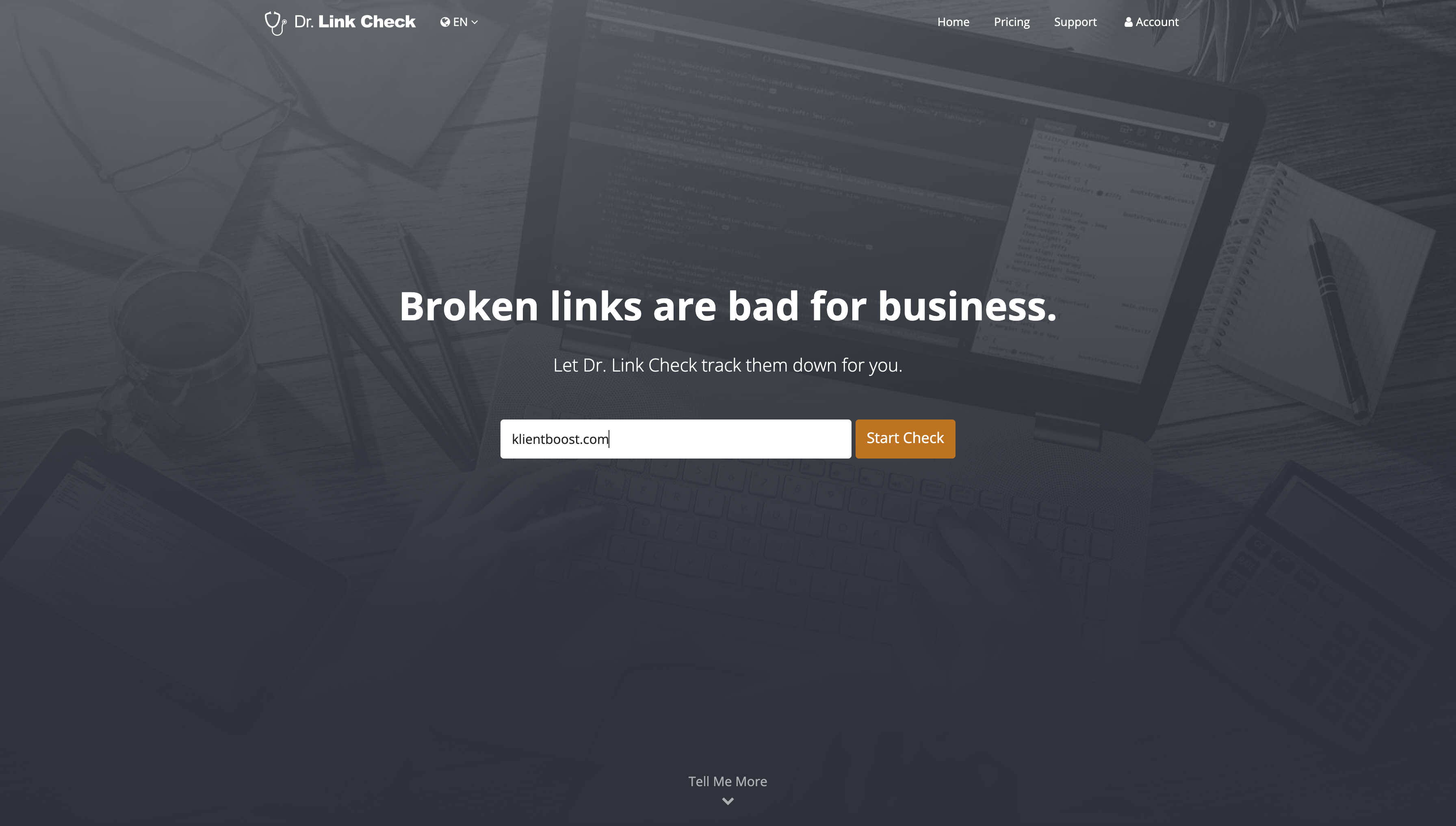
Second, go to the broken link tab.
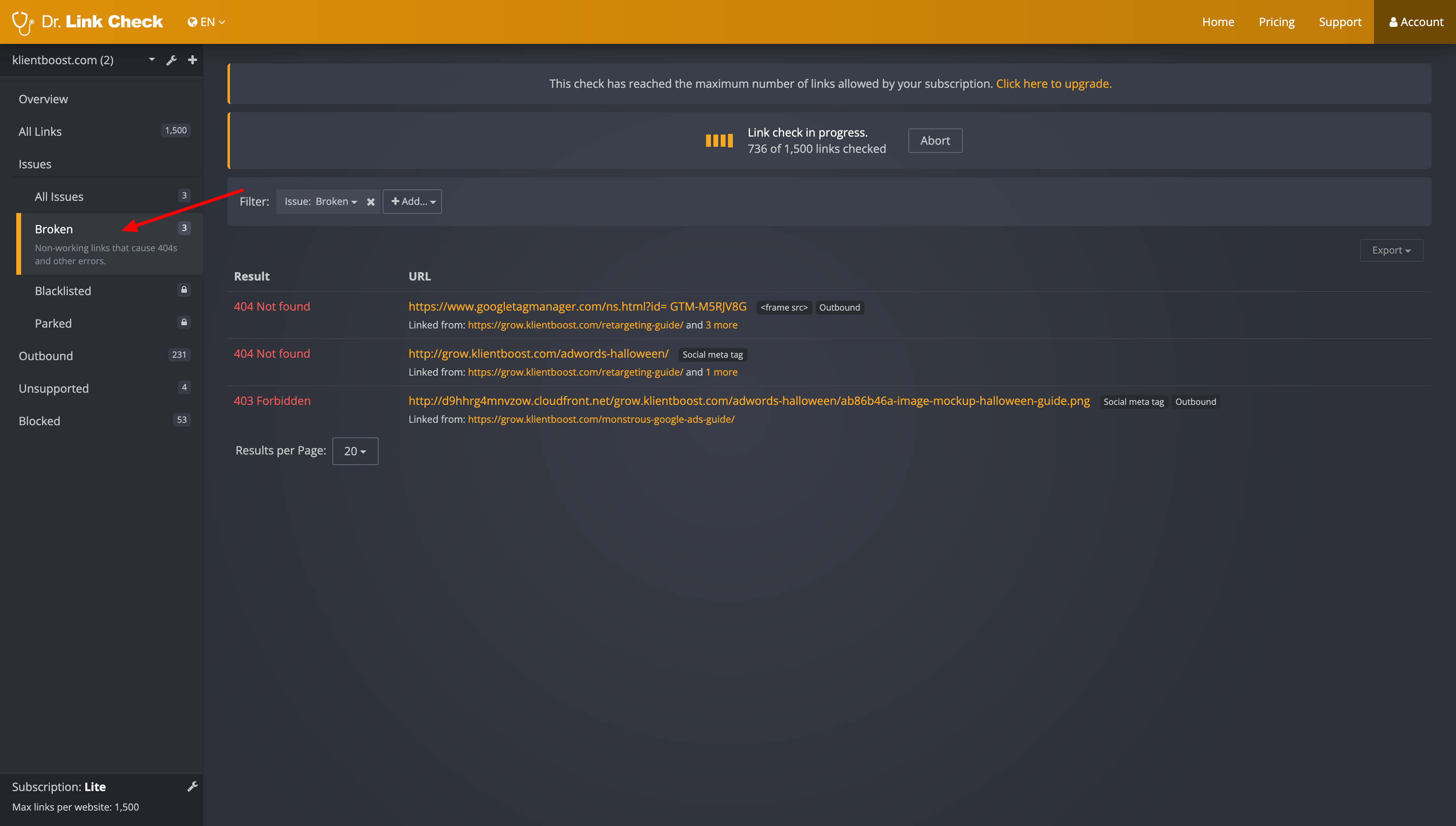
Third, add a URL filter and input your domain. Now you'll have a list of all internal broken links. Now go fix them!
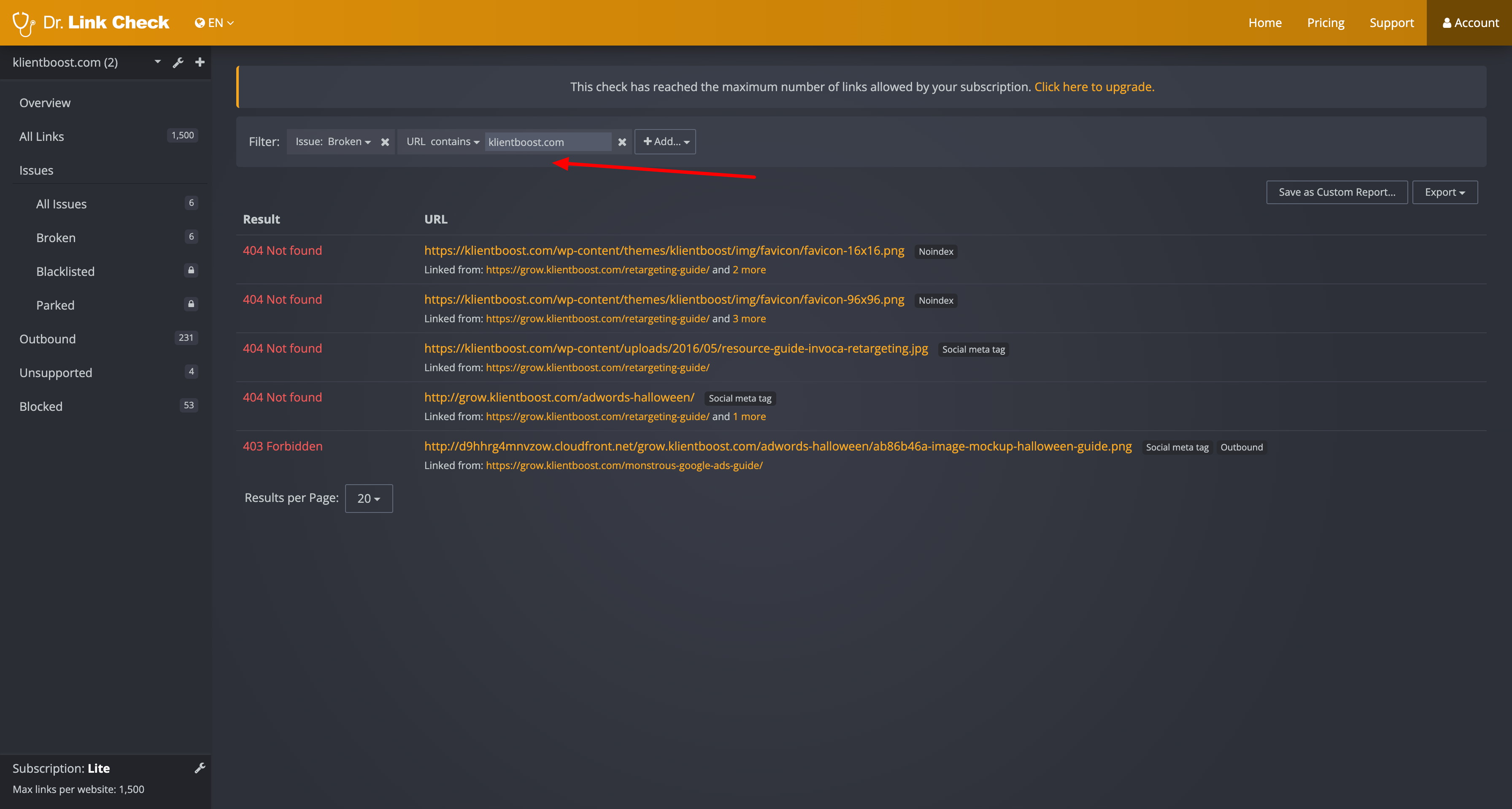
If you'd like, you can also browse for 404 errors in Google Analytics and find broken links that way. Dr. Link Check is easier though.
9. Use dofollow links 99.99% of the time
All links, internal or external, are either dofollow or nofollow.
In simplest terms, dofollow links tell Googlebot to pass page authority or link juice to the page it links to. As the name suggests, search engines follow dofollow links. And a dofollow link tells Google you trust the linked page.
Good news: dofollow is the default setting for links and you don't need to do anything to make them dofollow.
Nofollow links, on the other hand, tell Googlebot not to pass along link juice to the linking page. As the name suggests, search engines don't follow nofollow links. And a nofollow link is like telling Google you don't fully trust the linked page.
To make links nofollow, you have to update the link's HTML:
<a rel="nofollow" href="http://klientboost.com/seo">SEO agency</a>
99.99% of the time, when internal linking, you'll want links to be dofollow.
The only case where you might nofollow internal links is when you don't want a page indexed in Google, so you nofollow every link to that page. Note: you would also need to “noindex” the page too.
Internal linking strengthens the internal structure of your website
I hope by now one thing is clear: Internal links help your SEO. Like, a lot.
Follow the tips outlined in this article and you'll be on your way to higher rankings, more indexation, more conversions, and a better user experience through internal linking.
It's one of the quickest wins in your SEO arsenal.
Checklist: Internal Link Building for SEO Success
Internal link building is a crucial aspect of SEO success. Here are some tips to help you build internal links effectively:
- Use descriptive anchor text for internal links to help search engines understand the context of the linked page.
- Use internal links to connect relevant pages and help search engines understand the relationships between them.
- Use internal links to distribute link equity throughout your website and improve the ranking of important pages.
- Avoid using too many internal links on a page, as this can create an overwhelming user experience and look spammy.
- Use dofollow links to pass authority around your site via internal links.
- Put links high up on your page to reduce bounce rate and improve dwell time.
- Use internal links to help with indexing, especially for pages that are buried deep in your site’s architecture.
- Link strategically from your homepage to pages that need some juice.
- Use AI (like SurferSEO) to automate internal linking (by scrubbing your site and making connections).
- Add internal links to old pages as part of your quarterly SEO website audit.
By following these tips and building a solid internal linking strategy, you make the user experience better.
Google notices that and gives you an SEO high-five in the form of better search engine rank. When that happens, you get more visibility, which helps overall performance across all the metrics that count.
